Management of Invasive Mycoses in Hematology Patients: Current Approaches
Candidiasis and aspergillosis are the most common fungal infectionsin hematopoietic stem cell transplant recipients and other hematology/oncology patients. Strategies for reducing the morbidity and mortalityassociated with these infections include antifungal prophylaxis,empiric therapy in patients with persistent fever and neutropenia, andpreemptive therapy. Antifungal therapies include amphotericin B deoxycholate,lipid formulations of amphotericin B, the triazoles (fluconazole,itraconazole, and voriconazole), and the echinocandins (caspofunginand the investigational agents micafungin and anidulafungin).Fluconazole is a reasonable choice for the treatment of invasive candidiasisif the patient has not previously received a triazole and theinstitution has a low incidence of triazole resistance. If resistance is aconcern, an echinocandin, such as caspofungin, is an appropriate option.Voriconazole may be the initial choice in most patients with invasiveaspergillosis. If patients are intolerant of or refractory to conventionaltherapy, effective alternatives include a lipid formulation of amphotericinB or an echinocandin.
ABSTRACT: Candidiasis and aspergillosis are the most common fungal infectionsin hematopoietic stem cell transplant recipients and other hematology/oncology patients. Strategies for reducing the morbidity and mortalityassociated with these infections include antifungal prophylaxis,empiric therapy in patients with persistent fever and neutropenia, andpreemptive therapy. Antifungal therapies include amphotericin B deoxycholate,lipid formulations of amphotericin B, the triazoles (fluconazole,itraconazole, and voriconazole), and the echinocandins (caspofunginand the investigational agents micafungin and anidulafungin).Fluconazole is a reasonable choice for the treatment of invasive candidiasisif the patient has not previously received a triazole and theinstitution has a low incidence of triazole resistance. If resistance is aconcern, an echinocandin, such as caspofungin, is an appropriate option.Voriconazole may be the initial choice in most patients with invasiveaspergillosis. If patients are intolerant of or refractory to conventionaltherapy, effective alternatives include a lipid formulation of amphotericinB or an echinocandin.Invasive fungal infections continueto be an important cause of morbidityand mortality in hematology/oncology patients, particularlybone marrow or stem cell transplantrecipients. Amphotericin B deoxycholatewas once the standard of care;however, this agent is associated withsignificant adverse reactions, particularlynephrotoxicity. The lipid formulationsof amphotericin B are less toxicthan amphotericin B deoxycholate, butnephrotoxicity and infusion-relatedreactions continue to be concerns.These limitations have led to thedevelopment of alternative antifungalagents, such as the triazoles and, morerecently, the echinocandins. Thesenewer antifungals represent importantadvances in the prevention and managementof invasive fungal infections.This article will review the riskfactors for invasive fungal infections,the common organisms, and the conceptsof prevention and treatment, focusingon two major infectiousdiseases-invasive candidiasis andinvasive aspergillosis. This review isbased on material presented by Dr.Thomas Walsh.Risk Factors and OrganismsHematology patients at high riskfor invasive fungal infections includethose with the following:
- Acute leukemia, particularlyacute myelogenous leukemia, or thoseundergoing intensive consolidationand intensification and patients withhigh-risk acute lymphoblastic leukemia
- Chronic leukemia-specificallysubgroups with chronic myelogenousleukemia (CML) in blast crisis, multiplyrelapsed CML, and advancedchronic lymphocytic leukemia
- Lymphoma (multiply relapsed)
- Ongoing refractory myelodysplasia
- Severe aplastic anemia
- Transplantation (myeloablativeor nonmyeloablative)
Risk factors for aspergillosis in hematologypatients include prolongedor repeated episodes of profound neutropenia,corticosteroid therapy, andinfliximab therapy. Because tumornecrosis factor-alpha is a critical cytokinein host defense against
Aspergillus
,abrogating that cytokine canlead to increased risk for invasive aspergillosis.In addition to pharmacologicimmunosuppression, intrinsicimmune defects increase the risk ofaspergillosis. They include aplasticanemia, advanced HIV infection,chronic granulomatous disease, andJob syndrome.
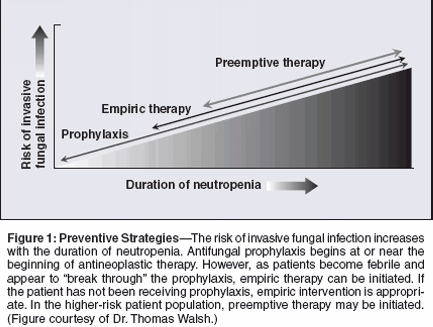
The most common fungal pathogensto cause significant infections inimmunosuppressed patients with malignancyand its treatment are
Candida
and
Aspergillus
. Less commonspecies, but ones that are being seenwith increasing frequency, includeyeast-like pathogens such as
Trichosporon
species and
Cryptococcus neoformans
.Other fungal pathogensinclude the filamentous fungi (particularlythe
Fusarium
species), the Zygomycetes,
Scedosporium
species,and a variety of dematiaceous molds.
Concepts of Prevention andTreatment
Over the past 25 years, differentstrategies have emerged for the preventionand treatment of invasive fungalinfections; where appropriate, theearly initiation of antifungal therapyhas been one of the hallmarks of theattempt to reduce complications fromthese infections. Three different-butoverlapping-strategies have beendescribed:
- Prophylaxis: The initiation ofantifungal therapy at or near the beginningof antineoplastic chemotherapyor hematopoietic stem celltransplant (HSCT) preparative regimen,before any symptoms or signsof infection.
- Empiric therapy: A risk-basedintervention for patients with persistentfever and neutropenia despitebroad-spectrum antibacterials andwho are at risk for invasive fungalinfections.
- Preemptive therapy: A riskbasedintervention for high-risk patientswho have persistent fever andneutropenia despite broad-spectrumantibiotics plus other evidence of invasivefungal infection, such as positivesurveillance cultures, sinusopacification, pulmonary infiltrates,or positive galactomannan antigen.
These approaches have been mostclearly described in the setting of neutropeniaduring the period of bonemarrow transplantation, as illustratedin Figure 1. There is substantial overlapbetween these strategies, especiallybetween empiric and preemptive therapy.For example, approximately 45%of patients enrolled in an empiric antifungaltrial may have pulmonary infiltrates;if so, the intervention is-bydefinition-preemptive therapy. Perhapswhat matters most is that a riskbasedapproach is used to preventinvasive fungal infections in high-riskneutropenic patients.
Prophylaxis
Toxicity is a key factor in determiningwhether a compound will beused early (prophylactically) or later(empirically) for the prevention of invasivemycosis. For example, if amphotericinB deoxycholate did nothave significant dose-limiting nephrotoxicity,it would be given as prophylaxisat a dosage of 1 mg/kg/d. Ina 1982 landmark study, Pizzo et al[1]delayed initiation of empiric amphotericinB (0.5 mg/kg/d) until at leastday 7 of persistent fever and neutropeniato justify the use of this toxicdrug only for higher-risk neutropenicpatients.This approach contrasts with theuse of fluconazole, where the therapeuticdosage (400 mg/d) is used forprophylaxis before the developmentof neutropenia in HSCT recipients.The seminal studies of Goodman etal[2] and Slavin et al[3] and subsequenttrials[4,5] demonstrate that fluconazolehas stood the test of time asan effective agent against
Candidaalbicans
, particularly for the preventionof invasive candidiasis in HSCTrecipients. Fluconazole prevented infectionwith all strains of
Candida
except
Candida krusei
. Breakthroughinfections do occur with fluconazole,and concerns about resistance of certainyeast species and molds have ledto studies of prophylaxis with newerantifungal drugs.The use of itraconazole to preventfungal infections in this setting hasbeen studied,[6,7] and although it hasbeen shown to be effective in highriskpatients, there continue to be concernsabout safety and potentialtoxicity with this particular drug. Forinstance, frequent gastrointestinal sideeffects, including nausea, vomiting,diarrhea, or abdominal pain, are associatedwith itraconazole; this drug canbe difficult to administer in some patientpopulations, and inconsistent oralabsorption is always an issue.

Van Burik et al,[8] of the MycosisStudy Group, recently studied a strategyof prophylaxis with the investigationalechinocandin micafungin. Itwas compared with fluconazole asprophylaxis in patients during the neutropenicphase of HSCT. The overallsuccess rate was higher with micafungin(80.0%) than with fluconazole(73.5%). The antifungal agents wereequally effective in the prevention ofinvasive candidiasis, but micafunginwas more effective than fluconazolein preventing mold infections such asaspergillosis. The two agents had comparablesafety profiles.Mattiuzzi et al[9] compared caspofungin(50 mg/d IV) and itraconazole(200 mg/d IV) prophylaxis in 192 patientswith hematologic malignancies.The incidence of invasive fungal infectionswas similar: 5.7% in thecaspofungin group (n = 106) and 5.8%in the itraconazole group (n = 86).Fewer
Candida
infections developedin the caspofungin group. It is clearthat in very high-risk patients, a prophylaxisstrategy that includes eitheran extended-spectrum azole or anechinocandin will be necessary to preventdeadly mold infections.
Empiric Therapy
The rationale for empiric antifungaltherapy in persistently febrile neutropenicpatients is to provide earlytreatment of occult invasive fungalinfection and prevent subsequentbreakthrough fungal infection in highriskpatients. It is likely that earlytreatment of a fungal infection is associatedwith a better outcome. Thisapproach to therapy should complementantifungal prophylaxis. The timingof empiric therapy is later in thecourse of neutropenia, so the populationreceiving treatment is smaller,but the risk of invasive fungal infectionis higher.Many of the studies of empiric antifungaltherapy have been relativelylarge. These studies have includedmore than 3,000 patients and haveevaluated many different antifungalagents, including amphotericin Bdeoxycholate,[1,10] liposomal amphotericinB,[11,12] fluconazole, anditraconazole.[13] Voriconazole hasbeen demonstrated to be effective inpreventing breakthrough fungal infectionsin high-risk patients with feverand neutropenia.[14] This drug wascompared with liposomal amphotericinB as empiric therapy in 837 patientswith neutropenia and persistentfever. The overall success rates werenot significantly different. However,the incidence of breakthrough infectionswas significantly lower in thevoriconazole group compared with theliposomal amphotericin B group(1.4% vs 9.2%).
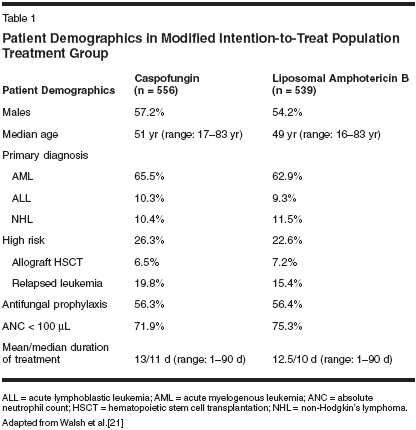
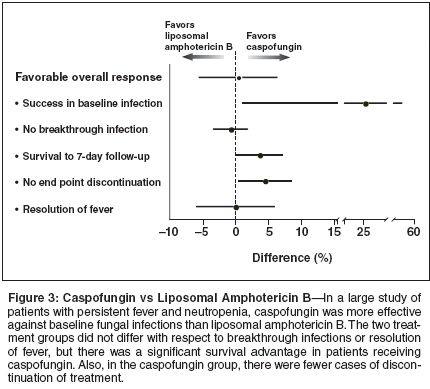
The number of patients discontinuingthe study drug because of toxiceffects was similar in the two groups.However, there were more discontinuationsbecause of lack of efficacy inpatients who received voriconazole(22 vs 5;
P
= .001), with persistentfever being the most common reasonfor withdrawal. Patients receiving voriconazolealso experienced more episodesof infusion-related visualtoxicity (21% vs 1%;
P
< .001). Thisagent is not currently FDA-approvedfor this indication.The recent data on the efficacy ofthe echinocandins for empiric antifungaltherapy are very encouraging.The echinocandins are a new class ofantifungal agent that inhibit the synthesisof cell wall glucans critical tothe integrity of many yeasts andmolds. As such, they have a uniquemechanism of action; cross-resistancewith conventional antifungal agentsis unlikely.The antifungal spectrum of theechinocandins includes
Candida
species,
Aspergillus
species, and
Pneumocystiscarinii
. Although no clinicaldata for pneumocystosis are available,the in vivo data are noteworthy. However,the echinocandins have no significantactivity against
C neoformans
.The major antifungal activity of echinocandinsagainst
Candida
and
Aspergillus
species can be explained bytheir chemical structure (Figure 2).The rationale for the early use ofechinocandins in the treatment and preventionof invasive mycoses in patientswith hematologic malignancies is basedon the strong data on the impact ofthese agents on invasive candidiasis andrefractory invasive aspergillosis.[15,16]The echinocandins have demonstratedencouraging activity against invasivecandidiasis and invasive aspergillosis,both in the laboratory and in clinicaltrials.[17-20]Laboratory investigations havedemonstrated that echinocandins areparticularly active in the early treatmentand prevention of invasive aspergillosis.The impact on earlydisease is striking. However, little clinicalevidence had been available concerningthe role of echinocandins inempiric antifungal therapy in persistentlyfebrile neutropenic subjects.Therefore, to address this lack ofknowledge, the largest empiric antifungaltherapy trial was conducted,involving more than 1,000 patients.[21] The patients had persistentfebrile neutropenia with hematologicmalignancies (Table 1). Approximatelythree-quarters of the patients hadacute leukemia, and the treatmentgroups were balanced with respect topatient age, gender, and underlyingdisease.The trial compared caspofungin (70mg on day 1, then 50 mg/d) with liposomalamphotericin B (3 mg/kg/d) asempiric antifungal therapy. The primaryend point was defined as survival to7 days post treatment, successful outcomeof baseline invasive fungal infection,the absence of breakthroughfungal infections to 7 days post treatment,no premature discontinuationbecause of lack of efficacy or drugtoxicity, and resolution of fever duringneutropenia.The results are shown in Figure 3.Overall success rates were equivalentin the two treatments, but caspofunginwas much more effective againstbaseline fungal infection. The groupsdid not differ with respect to breakthroughinfections or resolution of fever,but there was a significant survivaladvantage in patients receiving caspofungin.Also, in the caspofungingroup, there were fewer cases of discontinuationof treatment.In evaluating the efficacy againstbaseline fungal infections, the resultswere consistent with the activity observedin the laboratory, with caspofungindemonstrating virtually atwofold higher rate of successful outcome(Table 2). With respect to theimpact on survival at 7 days, caspofunginwas superior to liposomal amphotericinB (92.6% vs 89.2%,
P
=.044; Figure 4).
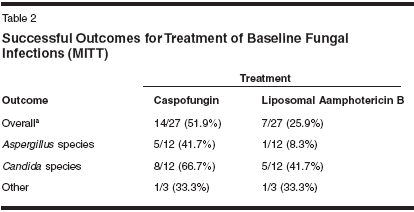
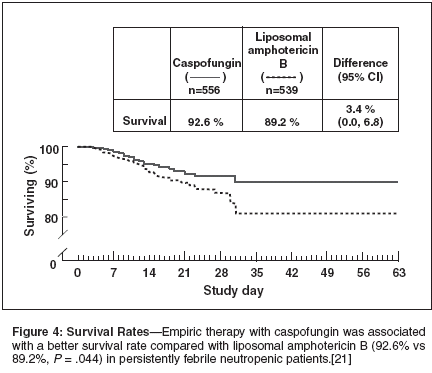
Findings from the safety analysisshowed that statistically fewer patientstreated with caspofungin suffereddrug-related adverse events, nephrotoxicity,or infusion-related events(Figure 5). Caspofungin was significantlybetter tolerated throughout thestudy.The results of this very large, rigorouslycontrolled clinical trial representan important advance in ourunderstanding of the impact of theechinocandins on early interventionin patients with hematologic malignancies.The results could potentiallychange the face of empiric antifungaltherapy. Since the final outcome ofmost of these studies showed no differencein final outcome with azoles,polyenes, or echinocandins, there aresome choices for clinicians to makein their strategies. However, it is clearthat caspofungin, with its safety, lackof drug interactions, and efficacy, willbecome an attractive choice to use asempiric therapy in high-risk febrileneutropenic patients.

Invasive Candidiasis
Types of Candidiasis
Infections with
Candida
species arecommon at all levels of clinical practice,evoking a broad range of diseases,from mucocutaneous infections,such as oral thrush, to life-threateninginvasive candidiasis within the hospitalsetting. In considering how to definitivelytreat invasive candidiasis, itis important to note that there are differentforms of infection.Candidemia is characterized by apositive blood culture and usually signifiesdeep tissue infection. The mortalityand morbidity associated withcandidemia are similar to those of bacteremiacaused by
Staphylococcusaureus
.[22] Thus, all cases of candidemiarequire treatment.Acute disseminated candidiasis,which represents an even greater burdenof tissue infection, is candidemiacomplicated by clinically overt deeptissue infection. It is characterized bycutaneous lesions, myalgias, hypotension,multiorgan dysfunction, and septicshock.Chronic disseminated candidiasisoccurs in stable ambulatory patientswho typically have fever, abdominalpain, and elevated alkaline phosphataselevels. There is usually a historyof neutropenia with or withoutcandidemia. In patients with chronicdisseminated candidiasis, the findingsare striking. For example, CT mayshow radiolucent lesions riddling theliver and spleen. Laparoscopy or openbiopsy usually shows multiple lesions.
Candida Species
The most common cause of candidemiais
C albicans
, which is responsiblefor approximately 50% ofcases.[23]
Candida glabrata
is thesecond most common cause of candidemia,responsible for as many as 25%of cases.[24]
Candida tropicalis
causesabout 10% to 15% of cases, but it ishighly virulent in neutropenic patients,causing severe fulminant acute disseminatedcandidiasis.
Candidaparapsilosis
is notorious for adheringto catheters and prosthetic devices andfor contaminating total parenteral nutritionsolutions. It often causes a persistentfungemia.
C krusei
accountsfor fewer than 5% of bloodstream isolates,but it is resistant to fluconazole.[25,26]Although
C glabrata
is less virulentthan some of the other
Candida
species, it often breaks through fluconazoleand voriconazole prophylaxis.Most blood isolates of
Calbicans
are susceptible in vitro tofluconazole but occasionally a resistantstrain will appear. Approximately10% of
C glabrata
isolates are fullyresistant to azoles, and about 10% arenow resistant to amphotericin B.
Candidalusitaniae, Candida guilliermondii
,and
Candida lipolytica
also areresistant to amphotericin B, and thereare increasing reports of amphotericinB-resistant isolates of
C glabrata,C krusei
, and
C tropicalis
.The National Committee for ClinicalLaboratory Standards has establishedinterpretive break points for theminimum inhibitory concentrations(MICs), which are used to determinewhether an isolate is susceptible orresistant.For fluconazole, "susceptible"is defined as a MIC of 8 g/mLor less, "susceptible dose-dependent"is 16 to 32 g/mL, and "resistant" is64 g/mL or higher.
Antifungal Therapy
The antifungal compounds availablefor primary treatment of candidemiainclude the polyenes(amphotericin B formulations), the triazoles,and the echinocandins. Thetriazoles include fluconazole and, recently,voriconazole. Voriconazoledoesnot have FDA approval for thetreatment of candidiasis, but data onsalvage therapy for refractory candidiasisare interesting.[27] Furthermore,data from a randomized clinical trialof voriconazole for candidemia havebeen presented in abstract form.Amphotericin B or fluconazole hasbeen recommended for the primarytreatment of candidemia.[28] However,as previously noted, dose-limitingnephrotoxicity may complicate theuse of amphotericin B. Although fluconazolehas a good safety profile, ithas limited activity against
C krusei
,some strains of
C glabrata
, andmolds,[25,26,29,30] and the developmentof resistance is a concern amongnon-albicans
Candida
species.The echinocandins represent a novelalternative to amphotericin B andfluconazole for the primary treatmentof invasive candidiasis.[31] Micafunginand anidulafungin are investigationalagents, with similar mechanismsof action, but comparative data areavailable only for caspofungin-showing that the drug is comparableto amphotericin B in the treatment ofcandidemia.[15]With respect to the selection ofprimary antifungal therapy for candidemia,there is no single correctchoice, but possible approaches includethe following:
- For institutions that have a lowfrequency of triazole resistance or forpatients who have not previously receivedantifungal triazoles, fluconazoleis a reasonably safe andcost-effective option.
- For institutions with a high frequencyof triazole resistance or forpatients receiving triazoles (includingfluconazole prophylaxis), it is appropriateto consider caspofungin.Furthermore, caspofungin is a goodchoice if there is a concern regardingdrug-drug interactions with the polyenesor azoles.
- For a patient who is hemodynamicallyunstable, consider usinganagent with greater fungicidal activity,such as caspofungin, should be considered.
- For patients with hepatotoxicity,therapy with a triazole should beavoided; therefore, it is appropriate touse liposomal amphotericin B orcaspofungin.
- For patients with nephrotoxicity,avoidamphotericin B because ofthe risks of further adverse effects onthe renal system and amphotericin Btoxicity.
If a patient has a positive bloodculture, there are additional considerations.Removal of vascular cathetersis recommended, but the caveat"where feasible" should be added. Inmany patients, the central venous cathetersare not readily removable; moreover,the catheter may not beincriminated in the infection.Ophthalmoscopy and abdominalCT scanning are recommended to ruleout endophthalmitis and hepatospleniccandidiasis and to stage the patient'sdisease. However, if the patientis neutropenic, this assessment shouldbe done upon recovery from neutropenia,because the inflammatory responsecan mute the CT findings andprevent the detection of positive vitreolaropacities. Thus, it is necessaryto ascertain infection at these sitesafter recovery from neutropenia.
Invasive Aspergillosis
Aspergillus
infection is now themost common cause of infectiouspneumonic mortality in HSCT recipientsand patients with leukemia. It isalso a major cause of pneumonia insolid-organ transplant recipients.It is important to understand thatthere is a bimodal distribution of aspergillosisin HSCT recipients. Thereis an early neutropenic phase of infectionthat is related to both the depthand the duration, and there is also alater postengraftment phase.Epidemiologic studies have describedthe bimodal distribution infrequency of aspergillosis in bonemarrow transplant recipients. Thepeaks of infection occur at a medianof 16 and 96 days after bone marrowtransplant. The risk factors for invasiveaspergillosis during the first peakinclude the following: donor type, underlyingdisease, season (summer),and transplantation outside an LAFenvironment. Risk factors for invasiveaspergillosis during the secondpeak include donor type, underlyingdisease, age, graft-vs-host disease,corticosteroid therapy, and neutropenia.[32]
Clinical Presentation andDiagnosis
Aspergillosis can cause sinusitis,of which nasal congestion may be theonly symptom, although physical examinationmay reveal eschars on thenasal turbinates. Early epistaxis mayoccur. A more ominous developmentis palatal hemierythema as the palatineveins are invaded, and therecan be dissemination to the CNS.Among the early manifestations ofaspergillosis, the emergence of pneumoniais a major concern. The presentationcan be very subtle, withpleuritic pain, cough, and hemoptysis.Any one of these symptoms in aneutropenic patient or otherwise immunocompromisedpatient clearly signifiesthe possibility of invasive aspergillosis.In the radiologic assessment ofpneumonia in this setting, the chestradiograph lacks sensitivity, but theCT scan may show bronchopneumonia,nodules, wedge-shaped infiltrates,halo signs, and cavities far more distinctively.The definitive diagnosis of invasivepulmonary aspergillosis may involveprocedures such as bronchoalveolarlavage, percutaneous needleaspiration, thoracoscopy, and, rarely,open lung biopsy. Microbiologic detectioninvolves direct examinationof specimens, histology, and culture.However, culture of respiratory secretionsare positive in only about50% of patients in whom polymerasechain reaction (PCR) results are positive.PCR remains investigational inthis setting, and there are technicalchallenges for its effective use. Bloodcultures are usually negative.Diagnostic tests for aspergillosisinclude serologic methods to detectcirculating antigens, such as cell wallgalactomannan and the 1,3,beta-Dgalactomannantest recently approvedby the FDA. The galactomannan detectionsystem is an enzyme immunoassayformat, which will enhanceand complement our diagnostic armamentaria.Galactomannan is a major heteropolysaccharidepresent in the cellwall, and it is a large molecular weightmolecule (between 25,000 and75,000). It was originally describedby Reiss and Lehman,[33] who firstrecognized its diagnostic utility.A number of studies have evaluatedthe use of galactomannan detectionin the diagnosis of invasiveaspergillosis.[34,35] Maertens etal[34] found that galactomannandetection had a sensitivity of 94.5%and a specificity of 98.8% inallogeneic stem cell transplant recipientswho had invasive aspergillosis.This statistical profile was better thanthat of other variables, such asunexplained fever, new pulmonaryinfiltrates, isolation of
Aspergillus
species,and CT abnormalities. Antigenemiapreceded the diagnosis on thebasis of radiologic examination by 8days in 80% of patients; antigenemiapreceded the diagnosis based on
Aspergillus
isolation by 9 days in 89%of patients.[34]In contrast, Herbrecht et al[35]found that the sensitivity of this testmay not be as high as anticipated.Their study had four patient groups:patients with fever of unknown originduring neutropenia, patients with suspectedpulmonary infection, thosewith nonpulmonary aspergillosis, andthose undergoing surveillance afterHSCT. A total of 3,294 serum sampleswere collected during 797 febrileepisodes.There were 153 episodes of invasiveaspergillosis: 31 definite, 67 probable,and 55 possible, and thesensitivity was 64.5%, 16.4%, and25.5% respectively. The sensitivitywas lower in patients who were positivefor anti-
Aspergillus
antibodiesthan in antibody-negative patients.Two recent publications have illustratedthe possible false-positive resultsthat can occur with the galactomannantest in patients receivingpiperacillin-tazobactam.[36.37] Inboth series, significant false-positiveresults were reported, and batches ofpiperacillin-tazobactam tested positiveby this assay.[36,37] It should be emphasizedto the reader that this testwas primarily assessed in patients withbone marrow transplant and hematologicmalignancies, and it may notperform as well in other high-risk populations.
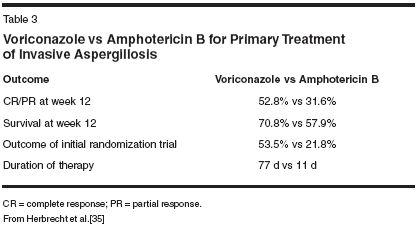
Treatment
The antifungal compounds for thetreatment of invasive aspergillosis includeamphotericin B deoxycholate,lipid formulations of amphotericin B,voriconazole, itraconazole, and caspofungin.Amphotericin B was previouslyconsidered the gold standard. Ithas the advantage of being activeagainst most species of
Aspergillus
,although an exception is
Aspergillusterreus
, which is resistant to amphotericinB.Itraconazole is available in bothIV and oral forms and is active againstmost species of
Aspergillus
. Studieshave reported good treatment responsesin invasive aspergillosis, with 32%of itraconazole-treated patientsachieving a complete or partial response.Patients must be able to takeoral medications, and drug interactionscan be problematic.[38]A study by Herbrecht et al[35] hasestablished our understanding of therole of voriconazole as primary therapyfor aspergillosis. This study wasan open, randomized comparison trialof voriconazole and amphotericinB deoxycholate, followed by otherlicensed antifungal therapy for invasiveaspergillosis. The regimen forvoriconazole was 6 mg/kg IV for twoloading doses on day 1, then 4 mg/kgq12h for at least 7 days, with an optionto follow by 200 mg q12h orally.Amphotericin B was given 1 to 1.5mg/kg/d IV.The study included 392 patients,most of whom were oncology patientsand HSCT recipients, and was conductedin Western Europe and NorthAmerica. The results demonstratedvoriconazole's superiority over amphotericinB with respect to both completeand partial responses, survival,overall outcome, and benefits in durationof therapy (Table 3).The echinocandins also are welltolerated and are active against most
Aspergillus
species. However, theyhave been studied only in the salvagesetting for advanced disease. In a studyof invasive aspergillosis in high-riskpatients who were refractory or intolerantto other antifungal agents, a partialor complete response was seen in41% of patients receiving caspofungin,compared with 17% of patientswho had received more than 1 weekof standard therapy.[39]The optimal dose of caspofunginin invasive aspergillosis is still uncertainbecause of varying results in differentanimal models. The role ofechinocandins may be much more definitivefor early empiric interventionin neutropenic patients or in those with
Candida
infection.Guidelines for the treatment of invasivepulmonary aspergillosis beginwith assessment of the patient's needfor parenteral vs oral therapy. Importantconsiderations are host factors,time factors, and bioavailability. Voriconazoleimproves survival comparedwith conventional amphotericin B andis the initial choice for most settings.If patients are intolerant of, or refractoryto, conventional therapy, a lipidformulation of amphotericin B orcaspofungin is recommended. Use ofcombination therapy remains imprecise,and such decisions must generallybe made at the bedside, withconsideration of all clinical factors.
Other Management Options
The role of surgery is important inthe management of invasive aspergillosis,and the indications for surgeryhave been defined in a numberof reports.[40,41] Indications for surgeryinclude the presence of infectedcatheters or implants, skin or softtissueinfections, invasion of the chestwall or pericardium, hemoptysis froma single cavitary lesion, and endocarditisor osteomyelitis (Table 4).Sinusitis is also an indication forsurgery in selected patients; however,this should not be considered during aperiod of profound neutropenia. Inthis setting, stabilization of diseasecan, upon recovery, be followed bymore aggressive intervention.In addition, in order to augmentthe host response against invasive aspergillosis,discontinue or rapidlytaper corticosteroids when feasible.Granulocyte-macrophage colonystimulatingfactor or granulocyte colony-stimulating factor for persistentbut reversible neutropenia is also recommended.There are individual reports of therole of interferon-gamma for augmentingthe host response, as well as supportivelaboratory data; however, inthe setting of BMT, this approachcould accelerate a T
H
1 response thatpromotes graft vs host disease. Granulocytetransfusions have a role, particularlyin patients with refractoryinfection and persistent but reversibleneutropenia.
Emerging Fungal Pathogens
Although this article has focusedon
Candida
species and
Aspergillusfumigatus
, there are other
Aspergillus
species that may be more resistant toamphotericin B.
Fusarium
is beingrecognized more frequently as an invasivepathogen in immunocompromisedpatients.
Fusarium
species maybe very unpredictable, and althoughvoriconazole has a second-line indicationfor infections caused by thesepathogens, many cases of fusariosisdo not respond to any of the availableclasses of agents.
Trichosporon
species are clearlyresistant to the fungicidal effects ofamphotericin B. They are amenableto triazole therapy but not to the echinocandins.The responses of
Pseudallescheriaboydii
or
Scedosporium
species are quite variable; some ofthem can use amphotericin B as anutrient carbon source. AmphotericinB remains the definitive treatment ofchoice for Zygomycetes; there arepromising data for the investigationaltriazole posaconazole, but this agentis not currently available. Infectionscaused by the dematiaceous molds,such as Phaeohyphomycetes, may respondto the extended-spectrum azoles.
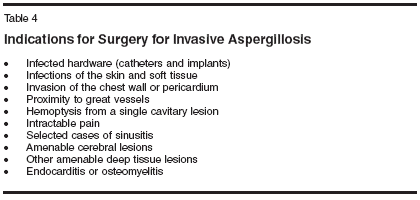
Disclosures:
Dr. Perfect has receivedresearch support from, acted as a consultant for,and served on speakers’ bureaus for Merck,Pfizer, Enzon, PLIZA, Schering-Plough, andFujisawa.
References:
1.
Pizzo PA, Robichaud KJ, Gill FA, et al:Empiric antibiotic and antifungal therapy forcancer patients with prolonged fever and granulocytopenia.Am J Med 72:101-111, 1982.
2.
Goodman JL, Winston DJ, Greenfield RA, etal: A controlled trial of fluconazole to preventfungal infections in patients undergoing bonemarrow transplantation. N Engl J Med 326:845-851, 1992.
3.
Slavin MA, Osborne B, Adams R, et al:Efficacy and safety of fluconazole prophylaxisfor fungal infections after marrow transplantation-A prospective, randomized, double-blindstudy. J Infect Dis 171:1545-1552, 1995.
4.
Marr KA, Seidel K, White TC, et al:Candidemia in allogeneic blood and marrowtransplant recipients: Evolution of risk factorsafter the adoption of prophylactic fluconazole.J Infect Dis 181:309-316, 2000.
5.
Rotstein C, Bow EG, Laverdiere M, et al:Randomized placebo-controlled trial offluconazole prophylaxis for neutropenic patients:Benefit based on purpose and intensityof cytotoxic therapy. Clin Infect Dis 28:331-340, 1999.
6.
Winston DJ, Busuttil RW: Randomizedcontrolled trial of oral itraconazole solutionversus intravenous/oral fluconazole for preventionof fungal infections in liver transplant recipients.Transplantation 74:688-695, 2002.
7.
Marr KA, Crippa F, Leisenring W, et al:Itraconazole versus fluconazole for preventionof fungal infections in patients receiving allogeneicstem cell transplant. Blood 103:1527-1533, 2004.
8.
Van Burik J, Ratanatharathorn V, LiptonJ, et al: Randomized, double-blind trial ofmicafungin (MI) versus fluconazole (FL) forprophylaxis of invasive fungal infections inpatients (pts) undergoing hematopoietic stemcell transplant (HSCT), NIAID/BAMSG protocol46. Presented at the 42nd InterscienceConference on Antimicrobial Agents and Chemotherapy;September 27-30, 2002; San Diego.Abstract M-1238.
9.
Mattiuzzi GN, Kantarjian H, Alvarado G,et al: Intravenous itraconazole (ITRA) vscaspofungin (CASPO) prophylaxis (P) in patients(PTS) with acute myelogenous leukemia(AML) and myelodysplastic syndrome (MDS)undergoing induction chemotherapy (IC). Presentedat the 43rd Interscience Conference onAntimicrobial Agents and Chemotherapy; September14-17, 2003; Chicago. Abstract M-984.
10.
EORTC International AntimicrobialTherapy Cooperative Group: Empiric antifungaltherapy in febrile granulocytopenic patients.Am J Med 86:668-672, 1989.
11.
Walsh TJ, Finberg RW, Arndt C, et al:Liposomal amphotericin B for empiricaltherapy in patients with persistent fever andneutropenia. N Engl J Med 340:764-771, 1999.
12.
Prentice HG, Hann IM, Herbrecht R, etal: A randomized comparison of liposomal versusconventional amphotericin B for the treatmentof pyrexia of unknown origin in neutropenicpatients. Br J Haematol 98:711-718, 1997.
13.
Boogaerts M, Winston DJ, Bow EJ, etal: Intravenous and oral itraconazole versusintravenous amphotericin B deoxycholate asempirical antifungal therapy for persistent feverin neutropenic patients with cancer who arereceiving broad-spectrum antibacterial therapy:A randomized, controlled trial. Ann Intern Med135:412-422, 2001.
14.
Walsh TJ, Pappas P, Winston DJ, et al:Voriconazole compared with liposomal amphotericinB for empirical antifungal therapy inpatients with neutropenia and persistent fever.N Engl J Med 346:225-234, 2002.
15.
Mora-Duarte J, Betts R, Rotstein C, etal: Comparison of caspofungin and amphotericinB for invasive candidiasis. N Engl J Med347:2020-2029, 2002.
16.
Denning DW: Echinocandins: A newclass of antifungal. J Antimicrob Chemother49:889-891, 2002.
17.
Bartizal K, Gill CJ, Abruzzo GK, et al:In vitro preclinical evaluation with theechinocandin antifungal MK-0991 (L-743,872). Antimicrob Agents Chemother41:2326-2332, 1997.
18.
Abruzzo GK, Flattery AM, Gill CJ, etal: Evaluation of the echinocandin antifungalMK-0991 (L-743,872): Efficacies in mousemodels of disseminated aspergillosis, candidiasis,and cryptococcosis. Antimicrob AgentsChemother 41:2333-2338, 1997.
19.
Denning DW. Echinocandin antifungaldrugs. Lancet 362:1142-1151, 2003.
20.
Deresinski SC, Stevens DA:Caspofungin. Clin Infect Dis 36:1445-1457,2003.
21.
Walsh TJ, Teppler H, Donowitz GR, etal: Caspofungin versus liposomal amphotericinB for empirical antifungal therapy in patientswith persistent fever and neutropenia. NEngl J Med 351:1391-1402, 2004.
22.
Kao AS, Brandt ME, Pruitt WR, et al:The epidemiology of candidemia in two UnitedStates cities: Results of a population-based activesurveillance. Clin Infect Dis 29:1164-1170,1999.
23.
Pfaller MA, Jones RN, Messer SA, et al:National surveillance of nosocomial bloodstreaminfection due to Candida albicans: Frequencyof occurrence and antifungal susceptibilityin the SCOPE Program. SCOPE ParticipantGroup. Surveillance and Control of Pathogens.Diagn Microbiol Infect Dis 30:327-332,1998.
24.
Pfaller MA, Jones RN, Messer SA, et al:National surveillance of nosocomial bloodstreaminfection due to species of Candidaother than Candida albicans: Frequency ofoccurrence and antifungal susceptibility in theSCOPE Program. SCOPE Participant Group.Surveillance and Control of Pathogens. DiagnMicrobiol Infect Dis 30:121-129, 1998.
25.
Rex JH, Rinaldi MG, Pfaller MA: Resistanceof Candida species to fluconazole.Antimicrob Agents Chemother 39:1-8, 1995.
26.
Pfaller MA, Jones RN, Doern GV, et al:Bloodstream infections due to Candida species:SENTRY antimicrobial surveillance programin North America and Latin America,1997-1998. Antimicrob Agents Chemother44:747-751, 2000.
27.
Hegener P, Troke PF, Fatkenheuer G:Treatment of fluconazole-resistant candidiasiswith voriconazole in patients with AIDS. AIDS12:2227-2228, 1998.
28.
Rex JH, Walsh TJ, Sobel JD, et al: Practiceguidelines for the treatment of candidiasis.Clin Infect Dis 30:662-678, 2000.
29.
Yamamura DL, Rotstein C, Nicolle LE,et al: Candidemia at selected Canadian sites:Results from the Fungal Disease Registry,1992-1994. CMAJ 160:493-499, 1999.
30.
Pfaller MA, Jones RN, Doern GV, et al:International surveillance of bloodstream infectionsdue to Candida species in the EuropeanSENTRY program: Species distributionand antifungal susceptibility including the investigationaltriazole and echinocandin agents.Diagn Microbiol Infect Dis 35:19-25, 1999.
31.
Walsh TJ: Echinocandins-An advancein the primary treatment of invasive candidiasis.N Engl J Med 347:2070-2072, 2002.
32.
Wald A, Leisenring W, van Burik JA, etal: Epidemiology of Aspergillus infections ina large cohort of patients undergoing bonemarrow transplantation. J Infect Dis 175:1459-1466, 1997.
33.
Reiss E, Lehman PF: Galactomannanantigenemia in invasive aspergillosis. InfectImmunol 25:357-365, 1979.
34.
Maertens J, Van Eldere J, Verhaegen J,et al: Use of circulating galactomannan screeningfor early diagnosis of invasive aspergillosisin allogeneic stem cell transplant recipients.J Infect Dis 186:1297-1306, 2002.
35.
Herbrecht R, Denning DW, Patterson TF,et al: Voriconazole versus amphotericin B forprimary therapy of invasive aspergillosis. NEngl J Med 347:408-415, 2002.
36.
Sulahian A, Touratier S, Ribaud P: Falsepositive test for aspergillus antigenemia relatedto concomitant administration of piperacillinand tazobactam. N Engl J Med 349:2366-2367,2003.
37.
Viscoli C, Machetti M, Cappellano P, etal: False-positive platelia aspergillus test inpatients receiving piperacillin-tazobactam. Presentedat the 43rd Interscience Conference onAntimicrobial Agents and Chemotherapy; September14-17, 2003; Chicago. Abstract M-2062b.
38.
Patterson TF, Kirkpatrick WR, White M,et al: Invasive aspergillosis: Disease spectrum,treatment practices and outcomes. Medicine(Baltimore) 79:250-260, 2000.
39.
Maertens J, Hiemenz JW, Raad II, et al:Efficacy of caspofungin as salvage therapy ininvasive aspergillosis as compared to standardtherapy in a historical cohort. Presented at the11th European Congress of Clinical Microbiologyand Infectious Diseases, 2001; Istanbul,Turkey. Abstract 248.
40.
Denning DW, Stevens DA: Antifungaland surgical treatment of invasive aspergillosis:review of 2121 published cases. Rev InfectDis 12:1147-1201, 1990.
41.
Reichenberger F, Habicht J, Kaim A, etal: Lung resection for invasive pulmonary aspergillosisin neutropenic patients with hematologicdiseases. Am J Respir Crit Care Med158:885-890, 1998.
Newsletter
Stay up to date on recent advances in the multidisciplinary approach to cancer.